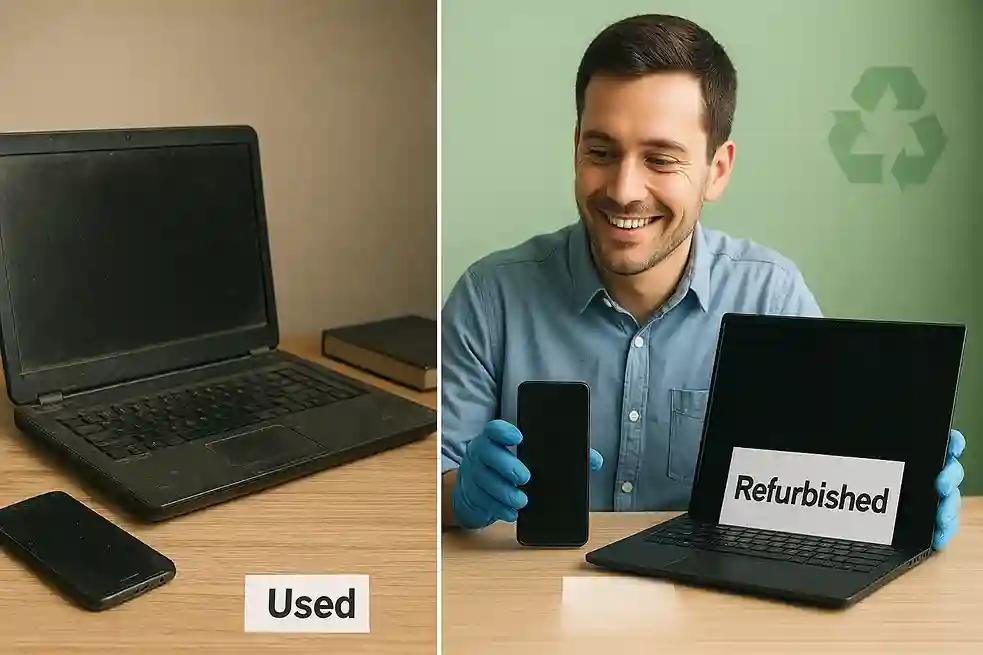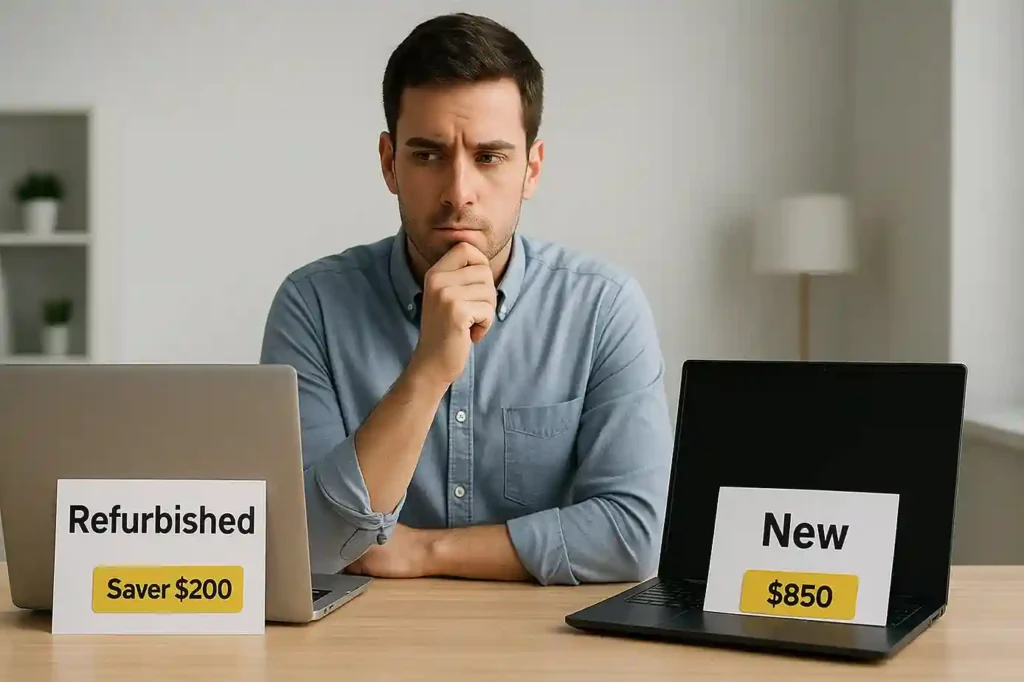Is refurbished tech worth it? This question has become common as more people search for affordable ways to upgrade their devices. Refurbished tech refers to items that were previously owned, inspected, repaired, and resold. Unlike used devices sold “as-is,” refurbished products go through testing to ensure they work close to new.
The dilemma is real for many U.S. buyers. New devices come with guaranteed performance, full warranties, and peace of mind. Refurbished devices, however, often cost far less and can offer nearly the same experience. The trade-off creates uncertainty. People ask whether the lower price truly balances the risks of shorter warranties, older batteries, or hidden wear.
This post will dig into the details. You’ll see the pros, including savings, sustainability, and access to premium models. You’ll also explore the cons, such as reliability concerns, limited warranty coverage, and inconsistent quality across sellers. We’ll cover how safety checks and certifications work, and what to look for before buying.
By the end, you’ll have a clear answer to the question: Is refurbished tech worth it compared to new? You’ll also know exactly when choosing refurbished makes sense—and when paying for brand-new may be the smarter move.
What Does Refurbished Tech Mean?

Is refurbished tech worth it? To answer, you need to understand what “refurbished” really means.
A used device is sold exactly as it was returned, with no repairs or testing. A refurbished device is different. It has been inspected, repaired if needed, and tested before resale. The goal is to bring it as close to “like new” as possible.
Who does the refurbishing matters a lot. Manufacturer-certified refurbished devices, like those from Apple, Dell, or Samsung, usually come with stronger warranties and stricter quality standards. Third-party refurbishers also sell devices, but their testing and quality can vary. Some are excellent, while others may cut corners.
In the U.S., the most common refurbished items are iPhones, laptops, tablets, and gaming consoles. These products hold high resale value and are often returned for reasons unrelated to performance, like buyers upgrading to newer models. That makes them attractive options for budget-conscious buyers.
Knowing the difference between used and refurbished helps you see why refurbished products are a middle ground. They cost less than new but offer more security than buying second-hand without any testing.
Here’s a quick comparison to make it clear
| Feature | Used Devices | Refurbished Devices | New Devices |
|---|---|---|---|
| Condition | Sold as-is | Repaired and tested | Factory fresh |
| Warranty | Rare or none | Limited, sometimes brand | Full manufacturer |
| Price | Lowest | Mid-range, cheaper than new | Highest |
| Reliability | Uncertain | Tested for performance | Guaranteed |
| Popular in USA | Older models | iPhones, laptops, consoles | All current models |
Pros of Buying Refurbished Tech

Lower Cost
Refurbished devices are often 20–50% cheaper than new. The savings can be even higher for older models, where prices drop sharply once newer versions are released. This price gap makes refurbished tech a practical option for students, families, and anyone trying to upgrade without overspending.
The cost advantage also opens access to premium models that may be unaffordable when new. For example, a refurbished flagship phone often costs the same as a brand-new mid-range model. The same applies to laptops and gaming consoles, where refurbished options let buyers enjoy higher performance at a lower price.
These savings can also stretch across multiple devices. Businesses and schools often choose refurbished tech in bulk because it keeps costs down without sacrificing usability. Over time, the lower upfront expense makes refurbished an attractive path for both individuals and organizations.
Eco-Friendly Choice
Buying refurbished helps reduce e-waste, one of the fastest-growing environmental issues today. Millions of phones, laptops, and tablets are discarded each year in the U.S. Many of these devices still work but end up in landfills, where harmful metals can leak into the environment.
Choosing refurbished extends the life of existing products. Instead of producing another new device, which requires mining raw materials, manufacturing, and shipping, a refurbished purchase reuses what’s already available. This lowers the demand for new production and reduces the overall carbon footprint.
For eco-conscious buyers, this choice has impact beyond personal savings. It supports a circular economy, where products are repaired, reused, and recycled rather than thrown away. Every refurbished device purchased is one less item contributing to electronic waste.
Warranty Protection
Many refurbished items include a limited warranty, which gives buyers extra peace of mind. The coverage is usually shorter than with brand-new devices, but it still protects against early defects or failures.
Manufacturer-refurbished or recertified products usually provide the strongest coverage. Major companies back these items with strict testing and clear return policies. That makes them safer options than uncertified sellers.
Third-party refurbishers may also provide warranties, but terms can vary widely. Some offer only 30 days, while others extend coverage for six months or more. The key is to check the details before buying.
Even a short warranty adds value because it shows the seller is confident in the product’s condition. Without it, buyers take on more risk. For most people, warranty coverage is one of the strongest reasons refurbished devices are worth considering.
Good as New Performance
Most refurbished devices perform almost like new. Many were customer returns with no major defects—sometimes returned simply because the buyer changed their mind. Others were lightly used items that only needed small repairs, such as a battery replacement or a cosmetic fix.
Before resale, these devices are tested and repaired to meet working standards. In some cases, they even receive software updates or new components. That means performance is often close to what you’d expect from a brand-new device. For everyday tasks like browsing, streaming, or schoolwork, refurbished tech can feel no different from new. High-end models that are refurbished may even outperform cheaper new alternatives. For example, a refurbished premium laptop often runs faster than a brand-new budget laptop at the same price.
While small differences may exist—like shorter battery life compared to brand-new models—many users find the performance gap minimal. This is why refurbished tech appeals to buyers who want quality devices without paying full retail price.
Cons of Buying Refurbished Tech

Shorter or No Warranty
Not all refurbished devices come with strong warranty coverage. Some only offer 30 to 90 days, while others may have no warranty at all. This depends heavily on the seller. Manufacturer-refurbished items usually include more protection, but uncertified sellers often provide very little. A shorter warranty means buyers carry more risk if something goes wrong later.
Limited Stock and Older Models
Refurbished tech is not always the latest release. Most options are older models that were returned or replaced after new versions launched. Stock can also be inconsistent, making it harder to find a specific model or configuration. For buyers who want cutting-edge features, refurbished options may not meet their expectations.
Cosmetic Flaws
While performance is tested, the outside condition may show signs of wear. Minor scratches, dents, or faded keys are common. These flaws do not usually affect performance, but they can affect the “new” feel of the device. Some sellers grade devices (A, B, C) so buyers know what to expect, but standards vary.
Risk with Non-Certified Sellers
The biggest concern comes from uncertified or untrustworthy sellers. Poor refurbishing practices can lead to hidden issues, bad replacement parts, or even devices sold as “refurbished” when they were only cleaned. In rare cases, scams involve fake branding or stolen devices. To avoid these risks, buyers should stick to manufacturer-certified or well-reviewed refurbishers.
Refurbished Tech: Pros vs. Cons
| Pros | Cons |
|---|---|
| 20–50% cheaper than new | Shorter or no warranty |
| Reduces e-waste | Older models, limited stock |
| Often includes warranty | Cosmetic flaws may be visible |
| Good as new performance | Risk from non-certified sellers |
This balance shows why the question “Is refurbished tech worth it?” depends on the buyer’s needs. For many, the pros outweigh the cons—but only if purchased from a trusted source.
Refurbished vs New – Key Differences
| Feature | Refurbished | New |
|---|---|---|
| Price | 20–50% cheaper | Full retail price |
| Warranty | Limited or 90 days (longer if brand) | Full coverage (1 year +) |
| Condition | Like-new, may show light wear | Perfect, factory fresh |
| Availability | Limited models, past versions | Latest and all models |
| Risk | Higher if uncertified | Very low |
When Refurbished Is Worth It
Premium Devices at a Discount
Refurbished tech makes the most sense when buying premium laptops, iPhones, or tablets. These products are built to last and often hold their value longer than budget devices. Many are returned in excellent condition—sometimes after only a few weeks of use.
The discounts can be significant. A refurbished iPhone or MacBook might cost hundreds of dollars less than the same model brand new. For many buyers, this makes premium devices finally affordable. Instead of settling for a budget laptop or mid-range phone, they can own a higher-end model at a reduced price.
This is especially useful for people who need strong performance for work, school, or creative projects but want to avoid paying full retail. In many cases, a refurbished premium device delivers nearly the same experience as new, without the financial strain.
Budget-Friendly Student Buys
Students benefit the most from refurbished deals. Popular choices include MacBooks, iPads, and Chromebooks, which are reliable for assignments, research, and online classes. Buying refurbished allows students to access devices that perform well without draining their limited budgets.
The savings are significant. A refurbished MacBook, for example, may cost 30–40% less than new, while a Chromebook could be even cheaper. These discounts free up money for other essentials like textbooks or software.
Another advantage is that student tech often doesn’t need to last for decades. Many students upgrade after graduation, so investing in a brand-new device isn’t always necessary. A refurbished laptop or tablet provides enough performance to get through school years at a fraction of the cost. For families with multiple students, refurbished devices are especially cost-effective. Buying two or three refurbished laptops often costs less than one premium new model, making it easier to equip every student with the tools they need.
Secondary or Backup Devices
Refurbished tech is also worth it when buying a second device. This could be a backup phone for emergencies, an extra laptop for home use, or even a gaming console for casual entertainment. Since these devices are not relied on as heavily as a primary one, the performance demands are lower.
For example, a refurbished tablet makes a great shared family device for streaming, reading, or light browsing. A refurbished console can serve as a secondary system for kids or casual gamers. Even an older refurbished laptop can handle simple tasks like emails, note-taking, or video calls without needing top-tier specs.
The value comes from not overspending on something you won’t use daily. Instead of paying full retail for a brand-new backup device, refurbished lets you save money while still getting solid functionality. For many households, this makes refurbished an easy and practical choice.
Eco-Conscious Buyers
For buyers focused on sustainability, refurbished tech is a smart decision. Electronic waste, or e-waste, is a growing problem in the U.S., with millions of devices discarded each year. Many of these items still have years of life left but end up in landfills, where toxic materials like lead and mercury can leak into the environment.
Choosing refurbished helps reduce this waste. Instead of demanding a brand-new device—which requires mining raw materials, heavy manufacturing, and long-distance shipping—eco-conscious buyers extend the life of an existing product. This simple choice lowers carbon emissions and reduces the strain on natural resources.
Refurbished tech also supports the idea of a circular economy, where products are reused, repaired, and recycled rather than thrown away. For environmentally aware consumers, buying refurbished is one of the easiest ways to align everyday tech purchases with sustainable values. At the same time, it remains cost-effective. Buyers do not have to sacrifice quality or pay premium prices to make a greener choice. They get reliable technology and make a positive environmental impact at the same time.
When New Is the Better Choice
While refurbished tech has many benefits, there are times when buying new is the smarter move.
Access to the Latest Technology
If you want the newest features, refurbished may not be an option. Cutting-edge devices, such as foldable phones, next-gen GPUs, and the latest gaming consoles, rarely appear on the refurbished market immediately. It often takes months, sometimes even a year, before returns or certified refurbishments become available.
For early adopters, this wait can be a deal-breaker. Buying new ensures you have access to the most advanced designs, upgraded hardware, and exclusive features the moment they’re released. Whether it’s improved camera systems, faster processors, or innovative display technology, brand-new devices guarantee you’re on the leading edge of performance and style.
In short, if staying current with the latest tech trends matters, choosing new is the only way to get there without delay.
Maximum Warranty and Insurance
New devices almost always include a full manufacturer warranty, which typically lasts a year or longer. This coverage protects against hardware defects, unexpected failures, and even software issues in some cases. On top of that, new purchases often qualify for extended warranties and device insurance plans. These add-ons provide extra protection, such as accidental damage coverage or replacement options, giving buyers long-term peace of mind.
Refurbished products, by comparison, usually come with limited coverage. Some carry a 90-day warranty, while others may offer none at all if purchased from uncertified sellers. Even when coverage exists, it may not match the comprehensive protection included with new devices.
For anyone who depends heavily on their tech, whether for work, school, or everyday life, the difference in warranty support is a major factor. If avoiding risk and ensuring reliable backup protection matters most, buying new is clearly the safer investment.
Business-Critical or Heavy Use
For business owners, professionals, or anyone who depends on technology every day, buying new can be the smarter decision. Devices used for critical tasks, long work hours, or demanding workloads need to perform at their best without interruption. A new device ensures you’re not starting with hidden wear, aging components, or previous repairs that could shorten its lifespan.
Another key advantage is warranty security. When your livelihood depends on a laptop, phone, or workstation, downtime can be costly. Full manufacturer warranties and service support give you the confidence that any issue will be resolved quickly. Refurbished tech, with its limited or uncertain coverage, often cannot provide the same level of assurance.
In these scenarios, reliability is more valuable than upfront savings. Spending more on new devices may seem costly, but the long-term stability, consistent performance, and lower risk of unexpected breakdowns make it a worthwhile investment for professionals and heavy users.
How to Buy Refurbished Safely
Buying refurbished tech can save money, but only if you shop carefully. Here’s how to reduce risks and find reliable deals.
Stick to Certified Sellers
The safest way to buy refurbished is through certified programs. Options like Apple Certified Refurbished, Dell Outlet, Best Buy’s Geek Squad Certified, and Amazon Renewed provide quality control, testing, and warranty support. These sellers follow strict refurbishment standards, making them far more trustworthy than random resellers.
Check Return Policy and Warranty
Always review the return policy and warranty details before buying. Certified refurbished items typically include at least 90 days of coverage, while manufacturer-refurbished products may offer one year. A good return window also gives you peace of mind in case the device doesn’t meet expectations.
Look for “Grade A” or “Like-New” Labels
Refurbished devices are often sold in different cosmetic “grades.” Grade A or Like-New devices usually have minimal wear and feel almost new. Lower grades may still work well but could show scratches, dents, or signs of use. Reading the product description carefully helps set realistic expectations.
Avoid Unknown Sellers
Be cautious of deals from unknown sellers or unprotected marketplaces. Some listings may use fake parts, skip proper testing, or even sell devices that were never truly refurbished. Always buy from sellers with strong reputations, buyer protections, and transparent refurbishment processes.
Final Verdict – Is Refurbished Tech Worth It?
Yes, refurbished tech is worth it for many U.S. buyers. If your priority is saving money and you don’t mind an older model, refurbished devices deliver strong value. They let you own premium laptops, phones, and tablets at a fraction of the cost. Choosing a certified refurbisher like Apple Certified Refurbished, Dell Outlet, or Amazon Renewed ensures reliability and often includes a warranty.
On the other hand, new tech is the smarter option when peace of mind is essential. If you want the latest features, full warranty protection, or a device for business-critical use, buying new makes sense. It offers unmatched reliability, insurance options, and the assurance of top performance.
In short, refurbished is best for budget-conscious, eco-friendly, or secondary device buyers, while new suits those who need cutting-edge technology and long-term coverage. The right choice depends on your needs, budget, and comfort with risk.
FAQs About Is Refurbished Tech Worth It?
Share Your Experience
Have you tried buying a refurbished laptop, phone, or console before? Share your thoughts and experiences in the comments below.

Amina Pierce is a tech-savvy blogger with a specialty in electronics, where she shares practical insights on gadgets, innovations, and the latest trends shaping our digital world. With a strong interest in how technology impacts everyday life, she breaks down complex topics into clear, easy-to-understand articles for readers of all backgrounds. While electronics is her main focus, Amina also enjoys writing on a variety of other subjects, including lifestyle, travel, and personal growth, making her content both diverse and engaging.
Outside of blogging, Amina loves tinkering with new devices, exploring smart home solutions, and capturing her experiences through travel photography. Her blend of technical knowledge and approachable style makes her a trusted source of information and inspiration.


